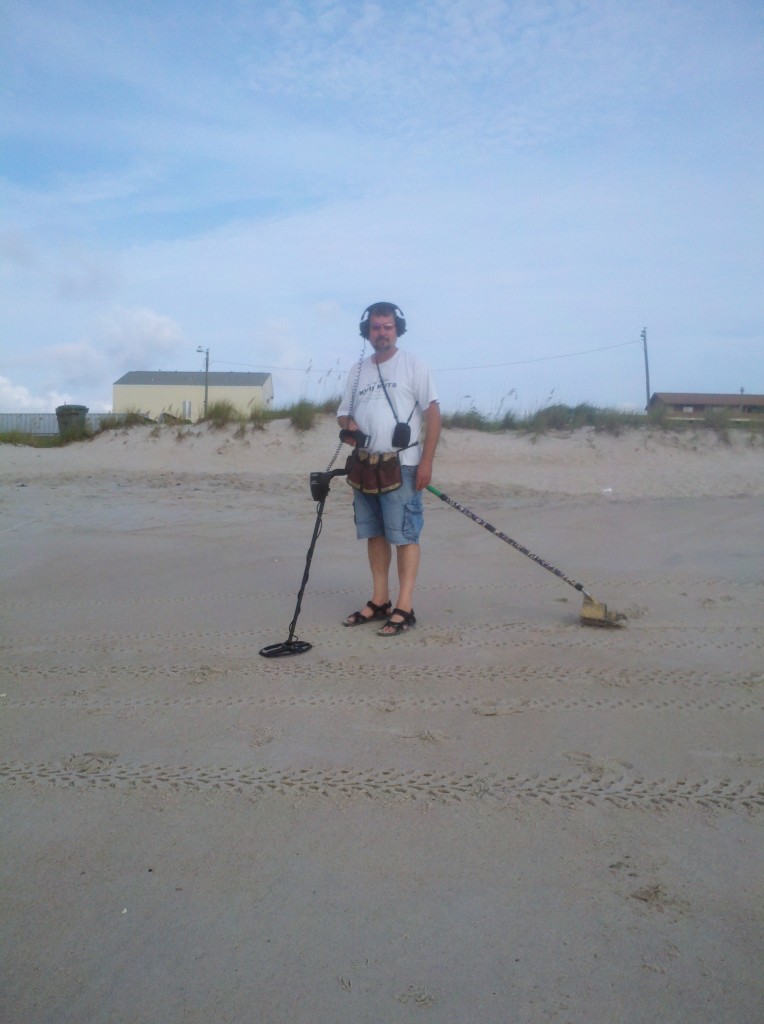Another reason for working beaches immediately after a storm is that the beach continually reshapes and protects itself. Sands shift normally to straighten t he beachfront and present the least possible shoreline to the sea’s continuous onslaught. During storms, beach levels decrease as sand washes out to form underwater bars which blunt the destructive force of oncoming waves. Following the storm, waves return this sand to the beach.
To understand how articles continually move around in the shallow ocean, consider the action of waves upon sand. At the water’s edge, particles of sand from the sand bank. When a wave comes in, sudden immersion in water causes the grains of sand to “lighten” and become more or less suspended in the water. Such constant churning keeps particles afloat until the next wave comes in. The floating particles are then carried some distance by the force of the water.
In the same manner, coins, jewelry, seashells and debris are continually relocated, generally in the direction of prevailing wind and waves. As they move, waves and wind carry material until a spot is reached where force of the water lessens. Heavy objects fall out and become concentrated in “nature’s traps.” So, whenever you find a concentration of seashells, gravel, flotsam, driftwood and other debris, work these areas with your metal detector.
Similarly, look for tidal pools and long, water-filled depressions on the beach. Any areas holding water should be investigated since these low spots put you closer to the blanket of treasure. As the tide recedes, watch for streams draining back into the ocean. These will locate low areas where you can get your search coil closer to the treasure.
As experience accumulates, you will discover “mislocated” treasure in areas away from people. How did this happen? Perhaps this is where people used to congregate; it might once have been a swimming beach. Then, for some reason, the old beach was abandoned along with its treasure. Another reason is natural erosion that redeposit objects. Even though such action is seldom permanent, always keep in mind the forces that cause it to happen-and watch for them in action. These forces do not occur accidentally, and they can create treasure vaults for you to find and unload.
When searching a large area of beach, you should clearly define your area of search and systematically scan every square foot. There are many grid methods to use, some simple, some elaborate. The simplest perhaps is to guide on your previous tracks as you double back and forth. Using a stick or other object you can draw squares in the sand. Work the first square completely and then draw an adjoining square and work it. These methods work if others don’t destroy your tracks and lines as fast as you make them.
You can drive stakes into the ground or just guide yourself on piers, trash containers, trees and other permanent objects.
When not following the tide out, some hobbyists prefer to walk a path parallel to the water. They then turn around, move about two feet away from the water and walk a return path. Others prefer to start at the high water mark and scan down to the water. They then turn around and walk a return path about two feet tot the side of their first path. This second method has more merit since it permits treasure troughs to be spotted more quickly.
Here’s how. These troughs, or “cut” areas that bring you closer to bedrock and the treasure blanket lying there, sometimes form parallel to the water line. When the tide goes out, the troughs fill with sand; still, they can sometimes be found. While scanning a path between high tide and the water’s edge, each time a find is made, either mark the location or remember it. After you have scanned some distance down the beach and made several finds, look back and study where you have worked. Observe the location of your finds to see if a pattern is developing. Most may have occurred in a narrow belt parallel to the waterline. If so, you’ve probably discovered the location of a buried trough where a storm or other wind and wave action have created a treasure vault. Empty it!
When selecting a beach on which to walk your grid pattern, seek one where you earlier observed a cut forming perpendicular to the waterline. High tides or waves pouring back into the ocean form these cuts, usually at low spot that have resulted from previous storms. Remember, cuts are important to you because they bring you closer to treasure; also, coins and jewelry washing off a beach are pushed into these cuts by streams of draining water.
Now that you will be searching in patterns rather than randomly, you will soon see the value of keeping precise logs of your treasure finds. Even with others working the same beach, it is likely that valuable patterns will emerge on the pages of your notebook that will lead you directly to “hot spots.” You may think that with others and yourself steadily working a particular beach, all its treasure would soon be recovered. Why keep track, you may ask. You’ll learn, however, that active beaches are continually replenished by “new” lost treasure and that all beaches add “old” treasures that tempests have withdrawn from deeply hidden storerooms.
Pay attention the next time you get close to turbulent surf. When a wave breaks near the beach, notice that water appears brown because of suspended sand. Crashing waves transport this sand onto the beach. If the waves are breaking perpendicularly j-at a ninety degree angle to the beach front- most of this sand is washed right back out to sea by the receding water.
Waves rarely break perpendicularly; rather, they bring sand in at an angle that sets up a current. This angle of transport washes sand to either side of its origination point. Some of the displaced sand remains on the beach and some is washed out to a new location. The result of this action is sand movement in the general direction of the waves.
Understanding this phenomenon is important because the same “ocean transport system” via storms and high waves causes a redistribution of treasure from the point where it was lost to its present location awaiting your metal detector. The ability of water to move heavier-than-sand material depends on its speed. Large waves and fast-moving currents can carry sand, coins and jewelry along a continuous path. When wave action slows down, movement subsides. When wave action picks up, movement resumes. Growing shores are ”nourished” by material that has been eroded from a nearby stretch of beach. Heavy treasure takes the path of least resistance, moving along the lowest points of cuts and other eroded areas. As coins and jewelry are swept into new beach areas, they become fill along with the new sand. Being heavier, they gradually sink to lower levels and become covered. When a beach or shore area has become fully “nourished,” the buildup essentially stops, leaving the treasure buried and awaiting the signal of a metal detector.
Since shorelines and beaches are continually being reshaped, you must be observant. One key to success is establishing permanent tide and sand markers. Such markers can be a piling or structure readily visible at any time. Ideally, your water marker will be somewhat submerged during both high and low tides. Checking this marker lets you measure water depth at all times to learn if the water is rising or falling.
Your marker in the sand is important because it is a gauge of sand height. Chances of finding treasure increase as more of this marker is exposed, indicating low sand levels. There are high and low sand formations. At low levels you may find treasure as it becomes uncovered by the action of wind and waves. High formations do you no good except to serve as gauges when storms erode cliffs. Imaginative beachcombers expect such erosion to reveal accumulations of debris and treasure that have been buried for decades. As noted earlier, stay alert for references to old settlements or ghost towns. What has been covered for generations may be uncovered before your eyes.


